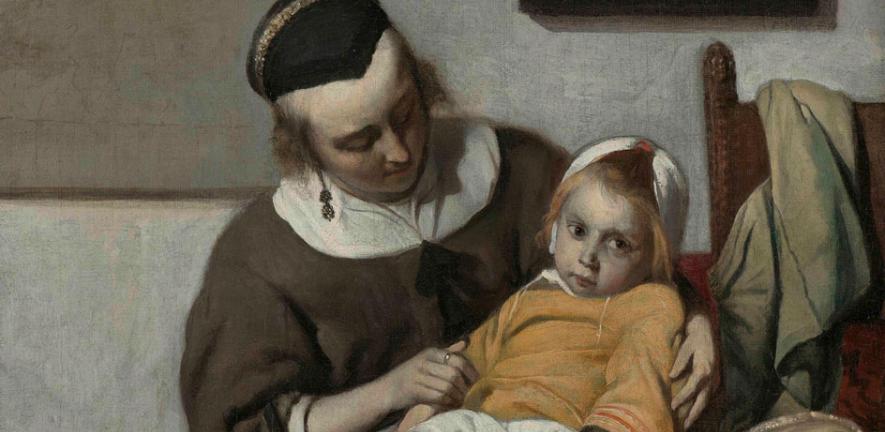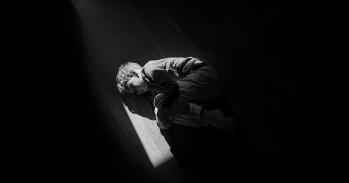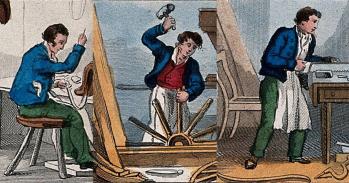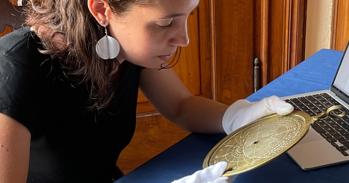
A new study into the grim and frequently heart-breaking history of childhood sickness and death has opened a window on to a surprisingly tender world of close families and devoted parenting in early modern England.
A new study into the grim and frequently heart-breaking history of childhood sickness and death has opened a window on to a surprisingly tender world of close families and devoted parenting in early modern England.
Parents had a deep-seated desire to look after their offspring. Faced with the desperate reality of a child falling ill, the niceties of gender or manly behaviour perhaps ceased to matter.
Hannah Newton
Life for children during the Tudor and Stuart age has often been depicted as a pretty miserable experience, characterised by disease, physical hardship, and aloof and strict parenting. But Dr Hannah Newton's book, The Sick Child in Early Modern England, 1580 - 1720, adds to an emerging view among historians that society at this time was not as unforgiving as we sometimes think.
Her investigation into the little-studied subject of how families responded to children falling ill and dying uncovers evidence for close familial ties, openly emotional fathers, and even the beginnings of specialist children's care among medical practitioners.
Drawing on sources like doctors’ casebooks, and the letters and diaries of parents, it also brings to life often heart-rending stories about parents who had to sit helplessly at their child's bedside, and of children who tried to keep their parents' spirits up even as they struggled for breath.
Newton chose her sombre topic because it provides an unusual level of insight into what life was like at the time, especially for children. She also wanted to understand more about society's attitudes to children, and how doctors and laypeople approached the task of treating them.
"We don't usually hear much about children's lives during the early modern age," Newton said. "When children became sick and died, however, this all changed. Parents often wrote detailed accounts of their child's life and death, desperate to convince themselves and their relatives and friends that the child had gone to heaven."
"They also wrote letters to other family members and medical advisers, which give us a real sense of what it was like to be there, because they recorded exactly what was happening and what the child was saying. Sources like this offer us a very rare opportunity to hear the voices of children speaking to us from the past."
Although childhood sickness has largely been neglected by researchers, in the 16th and 17th centuries it was a fact of life. Between a quarter and a third of children at this time died before they were 15. For every 1,000 babies born alive during the same period, between 123 and 154 did not make it past their first birthday.
The sheer rate of infant mortality alone has led some historians to conclude that parents were to some extent desensitised to the death of children. This has contributed to an overall picture of a society in which parents were often strict and distant figures.
Newton believes that the reality may often have been quite the opposite, however. The personal documents of parents who were trying to nurse their dying children, abound in expressions of unimaginable grief. Discovering the death of her little daughter Pegg in 1647, for example, one mother, Mary Verney, recorded: "I am not able to say one word more, but at this time there is not a sadder creature in the world."
The experience of child sickness also appears to have brought out the close bonds between family members and blurred gender distinctions. Mothers, fathers, aunts, uncles, grandfathers and grandmothers all turn up in the historical record coming to each other's aid.
Perhaps surprisingly for a society which placed such an emphasis on masculine and feminine "roles", the men's behaviour was often as openly emotional as that of the women. One account, of the death of 12-year-old Caleb Vernon from Battersea, records how, when Caleb knew he was dying, he bequeathed his toys to his sisters and then consoled his father, who had burst into tears at the bedside, that he “longed to be with God". He died a few moments later. The study also suggests that the affection of parents was often reciprocated passionately by their children.
Children, like their parents, believed that sickness was God's punishment for their sins. For both parties this could be a bittersweet experience. Parents felt desperate guilt as well as grief, and children themselves often reflected on how "naughty" they had been prior to their illness.
Yet there was also the prospect of going to Heaven, where parents and children believed that they would one day be reunited. In the 1670s, six-year-old Jason Whitrow took his mother by the hand, and said ‘Mother, I shall die, oh that you might die with me, that we might go to the Lord together’.
As well as the accounts of families, Newton has studied those of medical practitioners. These range from case notes and full-scale academic treatises to housewives’ recipe books, which at the time often included recipes for medicine.
They reveal evidence for what she terms "Children's Physic"; the first recognition among doctors that children were more than "small adults" and needed specialist care. Though hardly comparable with modern paediatrics, 17th century medics did regard children as physiologically distinct: their medicines had to be adapted to make them gentler and more pleasant – for example, sugar was added, and the dose was lessened. Doctors and laypeople were producing special remedies for children themselves, and taking age into account when treating their patients.
The picture of society that emerges is one in which children were, at least some times, treated with respect, compassion and care. "Parents and relatives had a deep-seated desire to look after their offspring, and when faced with the desperate reality of a child falling ill, the niceties of things like gender or manly behaviour perhaps ceased to matter," Newton said. "Investigating how children and their families responded to sickness and death tells us about far more than medicine: it provides a window into the emotional and spiritual lives of people from the past”.
The launch of The Sick Child in Early-Modern England, 1580 – 1720, published by Oxford University Press, will take place on Wednesday, 25 April.
Case notes: How records of illness allow children to speak to us from the past.
It is notoriously difficult to investigate the experience of childhood in the seventeenth century. Children rarely left written records. However, there is one context in which their voices do survive: illness. Acutely aware of the likelihood of death, parents recorded the thoughts, words, and actions of their sick children in detail. The resulting evidence provides rare and intimate insights into the lives and deaths of seventeenth-century children. Below, a sample of children’s stories are given; they are taken from parents’ diaries and doctors’ casebooks.
As she climbed into bed one October night in 1625, three-year-old Elizabeth Wallington said to her father, ‘Father, I go abroad tomorrow and bye you a plomee pie’. Her father, Nehemiah, recorded in his diary that ‘these were the last words that I did here my sweete child speeke’, for several hours later ‘the very panges of death seassed upon her’. She ‘continued in great agonies (which was very grievous unto us the beholders)’ for two days, and died at ‘foore a clocke in the morning, being the eleventh day of October’. Elizabeth’s death greatly affected Nehemiah: he was ‘much disstrackted in my mind and could not be comforted’. This man, a carpenter from London, was to lose four of his five children to childhood disease.
At two o’clock in the morning in 1675, twelve-year-old Caleb Vernon from Battersea, sick of consumption, announced, ‘Now I think I shall die’. He bequeathed ‘all his toyes’ and his pet bird to his sisters Nancy and Betty, and told his mother ‘I love your company dearly’. Seeing his father ‘gush into tears’, he pleaded, ‘Father do not weep, but pray for me[:] I long to be with God’. Caleb began to grow breathless, ‘as if choaked with plegm’, and his father, who was ‘in great care for him’, ran downstairs to fetch some medicines ‘for his relief’. Returning quickly, he saw his son ‘thrusting, first, his finger, and then his whole hand in to his mouth’ to clear his throat. Hearing his father coming, Caleb gasped, ‘O Father, what shall I do!’, and then ‘immediately lay back’, uttered ‘God, God’, and died.
One afternoon in the 1630s, fourteen-year-old boy Richard Gilmore vomited ‘black Worms, about an inch and a half long, with six feet, and little red heads’. After vomiting, he ‘was almost dead, but a little time after he revived’. The next day, the boy’s father went to see a doctor from Stratford called John Hall, ‘earnestly desiring’ his advice. He brought with him some of the worms ‘wrapped in Paper’, which, upon examination, ‘crept like Earwigs’. The boy was so ‘cruelly afflicted’ that ‘he was ready to tear himself to pieces’ to remove the worms. Dr Hall administered a remedy which made the boy vomit seven times, and bring up ‘six Worms’, the like of which the doctor had ‘never beheld or read of’ before. Dr Hall noted in his casebook that these treatments ‘delivered’ the boy of his infestation, so that when he visited him two years later, he ‘told me he had never been troubled with it since’.
This work is licensed under a Creative Commons Licence. If you use this content on your site please link back to this page.





